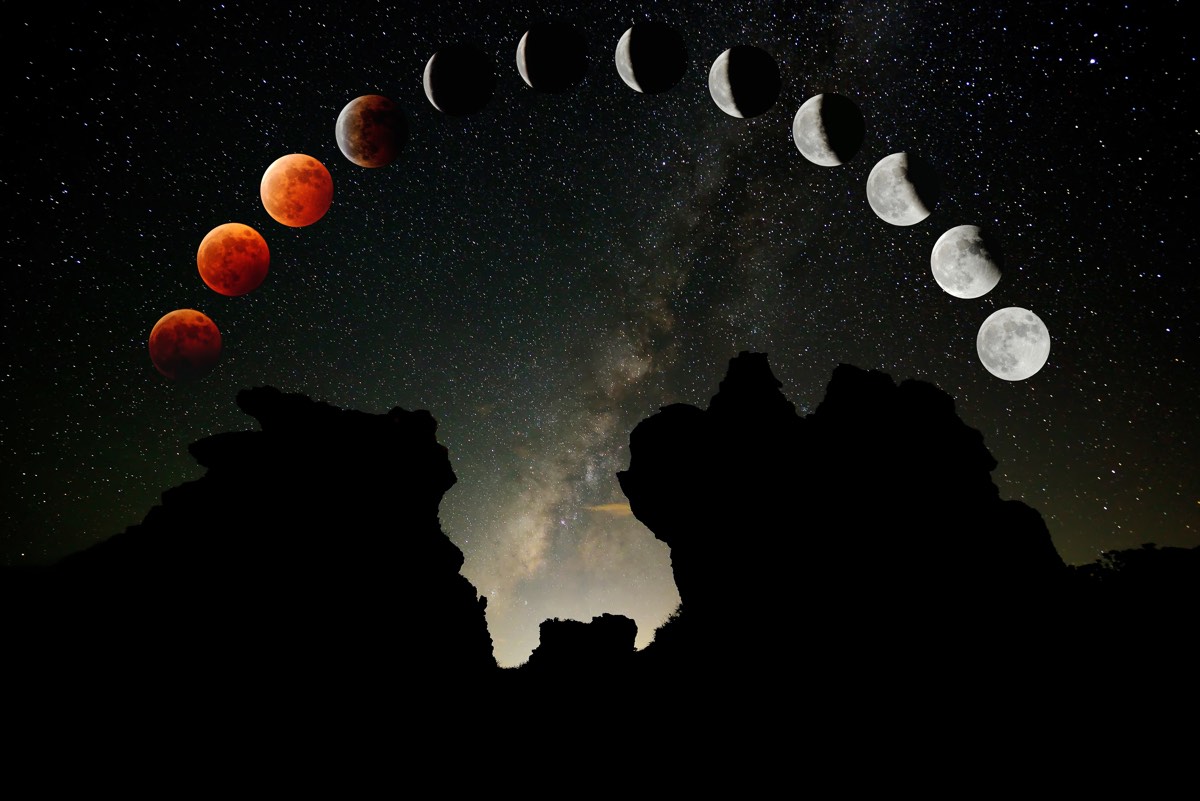What to Expect from the Super Blood Wolf Moon Eclipse

Call in late to work on Monday (Jan. 21) and prepare to spend Sunday night staring at the sky: The Super Blood Wolf Moon eclipse is coming.
That's a mouthful, but let's break it down. January's full moon is a supermoon, meaning that the moon is at the point in its orbit where it is nearest to Earth. This is called perigee. The average distance from Earth to the moon is 238,855 miles (384,400 kilometers). At perigee this January, the distance will shrink to 222,043 miles (357,344 km). At the moon's next apogee in February, when the moon is farthest from Earth, it will be 252,622 miles (406,555 km) away from Earth.
Practically speaking, perigee is hard to detect with the naked eye. As the editor of Sky & Telescope magazine Alan MacRobert noted in advance of a 2016 supermoon, the moon looks about 25 percent brighter and around 15 percent greater in area at perigee — "not enough to notice unless you're a very careful moon-watcher," he said. [Here's How to Watch Sunday's Lunar Eclipse]
Blood and wolves
The "wolf" part of this month's moon moniker is simply a reference to the month of January. According to the Farmers' Almanac, each month's full moon has a name, supposedly cobbled together from traditional Native American or old Anglo-Saxon names. No one knows the precise origin of "wolf moon," but that's the name typically assigned to January. [Photos: The Adventure Behind Eclipse Chasing]
The rest of the name is all about planetary geometry. This month, as the moon swings closest to Earth, the moon will also undergo a total lunar eclipse. Lunar eclipses happen when Earth is between the sun and the moon, and the moon passes into Earth's shadow.
"Not just any part of the shadow," said Paul Hayne, an astrophysicist at the University of Colorado Boulder, "but the deepest, darkest part of the shadow, called the umbra."
Despite the moon's position in this deep shadow, it won't entirely vanish from Earthlings' sight. A little bit of sunlight sneaks through Earth's atmosphere, bent and scattered by the thin sheen of gases blanketing our planet. Red wavelengths of light pass through, creating an eerie vermilion hue on the moon's face for viewers on Earth. From the moon, it would look as if Earth were surrounded by an orange ring of fire.
Sign up for the Live Science daily newsletter now
Get the world’s most fascinating discoveries delivered straight to your inbox.
"It's like seeing a sunset all the way around the Earth," Hayne told Live Science. Because of the color, lunar eclipses are also known as "blood moons."
Where to watch
The total eclipse of the moon will last an hour and 2 minutes, according to NASA, with the partial phase stretching out over 2 hours and 17 minutes. The show starts subtly at 9:36 p.m. EST (6:36 p.m. PST) with a penumbral eclipse, when the outer edge of Earth's shadow will very slightly darken the moon's face. Things will get a little more interesting around 10:34 p.m. EST (7:34 PST), when the moon enters the main, darker portion of Earth's shadow, the umbra. This marks the start of the partial lunar eclipse.
At 11:41 p.m. EST (8:41 PST), the total eclipse begins. At this point, the moon will be entirely within the umbra, and the whole surface should appear dusky red. The total eclipse will last until 12:43 a.m. EST (9:43 p.m. PST), and the partial eclipse will end at 1:51 a.m. EST (10:51 p.m. PST). The final, subtle darkening of the penumbral eclipse will pass at 2:48 a.m. EST (11:48 p.m. PST). Weather permitting, most of the United States — except for Hawaii and some of the Aleutian Islands — will have a great view, Hayne said.
"The next total eclipse is not until 2021 in May, and there won't be nearly as good visibility in the U.S. for that one," he said.
Hayne will be watching the eclipse from a less-than-perfect perch in Hawaii, where the moon won't rise until much of the show is already over. He and his fellow scientists will be viewing the eclipse using a thermal infrared camera at an observatory there. As the moon passes into Earth's shadow, Hayne said, it begins to cool off. Different materials cool off at different rates, so the infrared view allows researchers to see surface features that are usually hard to discern.
"We can actually see the youngest impact craters on the moon's surface pop out like crazy when the moon goes into an eclipse," Hayne said.
- Moon Myths: The Truth About Lunar Effects on You
- 6 Wild Ways the Moon Affects Animals
- See Gorgeous Pics of the #SuperBlueBloodMoon Eclipse
Originally published on Live Science.

Stephanie Pappas is a contributing writer for Live Science, covering topics ranging from geoscience to archaeology to the human brain and behavior. She was previously a senior writer for Live Science but is now a freelancer based in Denver, Colorado, and regularly contributes to Scientific American and The Monitor, the monthly magazine of the American Psychological Association. Stephanie received a bachelor's degree in psychology from the University of South Carolina and a graduate certificate in science communication from the University of California, Santa Cruz.









